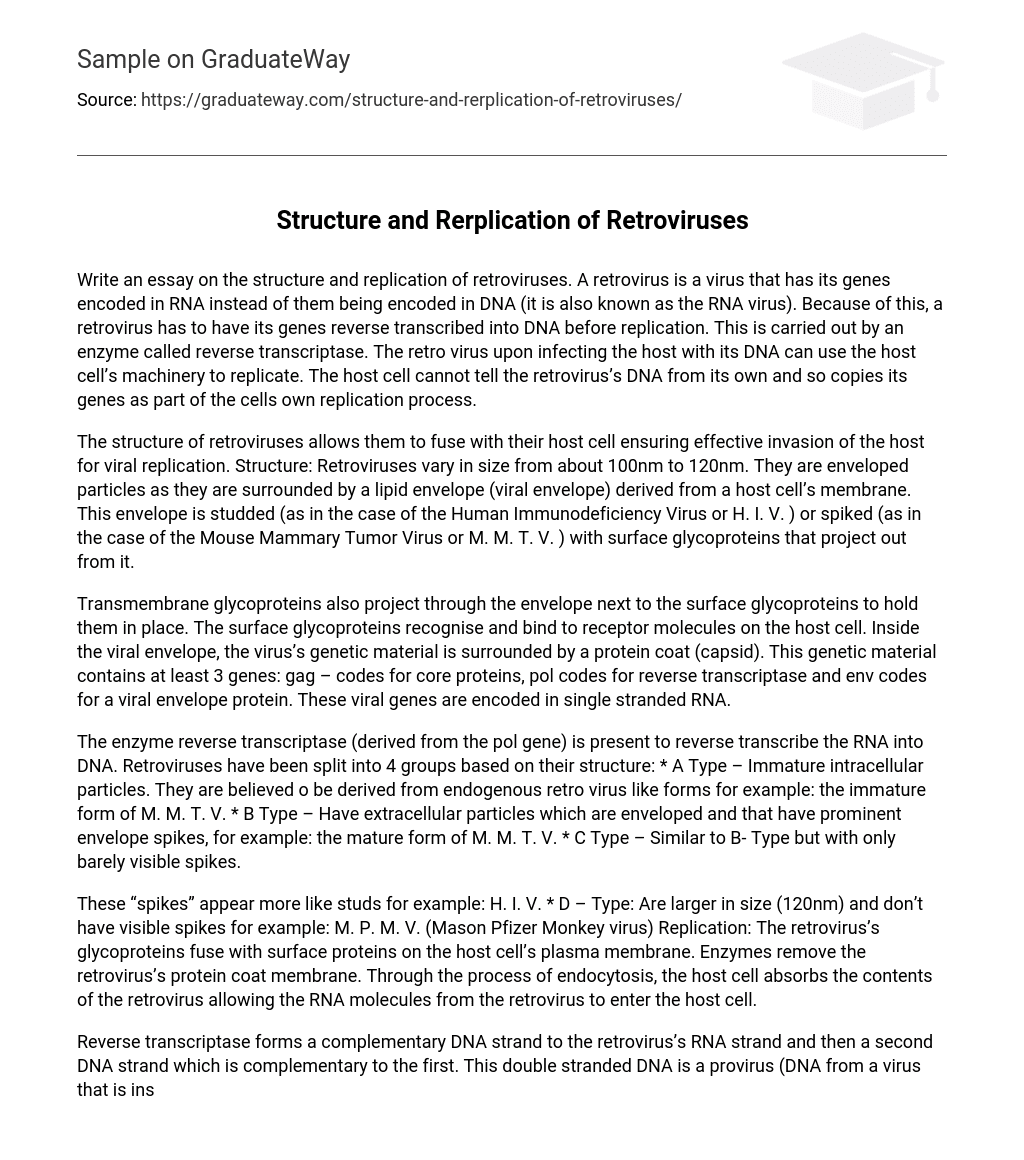Write an essay on the structure and replication of retroviruses. A retrovirus is a virus that has its genes encoded in RNA instead of them being encoded in DNA (it is also known as the RNA virus). Because of this, a retrovirus has to have its genes reverse transcribed into DNA before replication. This is carried out by an enzyme called reverse transcriptase. The retro virus upon infecting the host with its DNA can use the host cell’s machinery to replicate. The host cell cannot tell the retrovirus’s DNA from its own and so copies its genes as part of the cells own replication process.
The structure of retroviruses allows them to fuse with their host cell ensuring effective invasion of the host for viral replication. Structure: Retroviruses vary in size from about 100nm to 120nm. They are enveloped particles as they are surrounded by a lipid envelope (viral envelope) derived from a host cell’s membrane. This envelope is studded (as in the case of the Human Immunodeficiency Virus or H. I. V. ) or spiked (as in the case of the Mouse Mammary Tumor Virus or M. M. T. V. ) with surface glycoproteins that project out from it.
Transmembrane glycoproteins also project through the envelope next to the surface glycoproteins to hold them in place. The surface glycoproteins recognise and bind to receptor molecules on the host cell. Inside the viral envelope, the virus’s genetic material is surrounded by a protein coat (capsid). This genetic material contains at least 3 genes: gag – codes for core proteins, pol codes for reverse transcriptase and env codes for a viral envelope protein. These viral genes are encoded in single stranded RNA.
The enzyme reverse transcriptase (derived from the pol gene) is present to reverse transcribe the RNA into DNA. Retroviruses have been split into 4 groups based on their structure: * A Type – Immature intracellular particles. They are believed o be derived from endogenous retro virus like forms for example: the immature form of M. M. T. V. * B Type – Have extracellular particles which are enveloped and that have prominent envelope spikes, for example: the mature form of M. M. T. V. * C Type – Similar to B- Type but with only barely visible spikes.
These “spikes” appear more like studs for example: H. I. V. * D – Type: Are larger in size (120nm) and don’t have visible spikes for example: M. P. M. V. (Mason Pfizer Monkey virus) Replication: The retrovirus’s glycoproteins fuse with surface proteins on the host cell’s plasma membrane. Enzymes remove the retrovirus’s protein coat membrane. Through the process of endocytosis, the host cell absorbs the contents of the retrovirus allowing the RNA molecules from the retrovirus to enter the host cell.
Reverse transcriptase forms a complementary DNA strand to the retrovirus’s RNA strand and then a second DNA strand which is complementary to the first. This double stranded DNA is a provirus (DNA from a virus that is inserted into a host’s genome) and is incorporated into the host’s chromosomal DNA, where, as in the case of H. I. V. it may lay dormant for a number of years. The provirus is transcribed into RNA which travels out of the nucleus into the cytoplasm and is used in the formation of the next generation of viruses and for other virus proteins.
The RNA and reverse transcriptase molecules bundle together and assemble to allow a protein coat to form around them. As they leave the host cell by budding out from it, they using the host cell’s plasma membrane to form their viral envelope. Because retroviruses directly affect their host cell’s DNA, they can be a cause of cancer. The integration of proviral DNA into the host’s chromosomal DNA can cause the formation of tumours which are usually benign. The most oncogenic retroviruses have a combination of both viral and host genes.
In this instance, the host genes are usually the cause of cancer as they can cause mutations to arise. Although retroviruses are the cause of many illnesses, new research is being carried out so that we may be able to use them in gene therapy. Because of their process of replication, retroviral vectors can potentially be used to permanently modify the host cell’s genome in a beneficial way. However, this area still requires a lot of research. http://www. accessexcellence. org/RC/VL/GG/retrovirus. php (diagram based on HIV)





